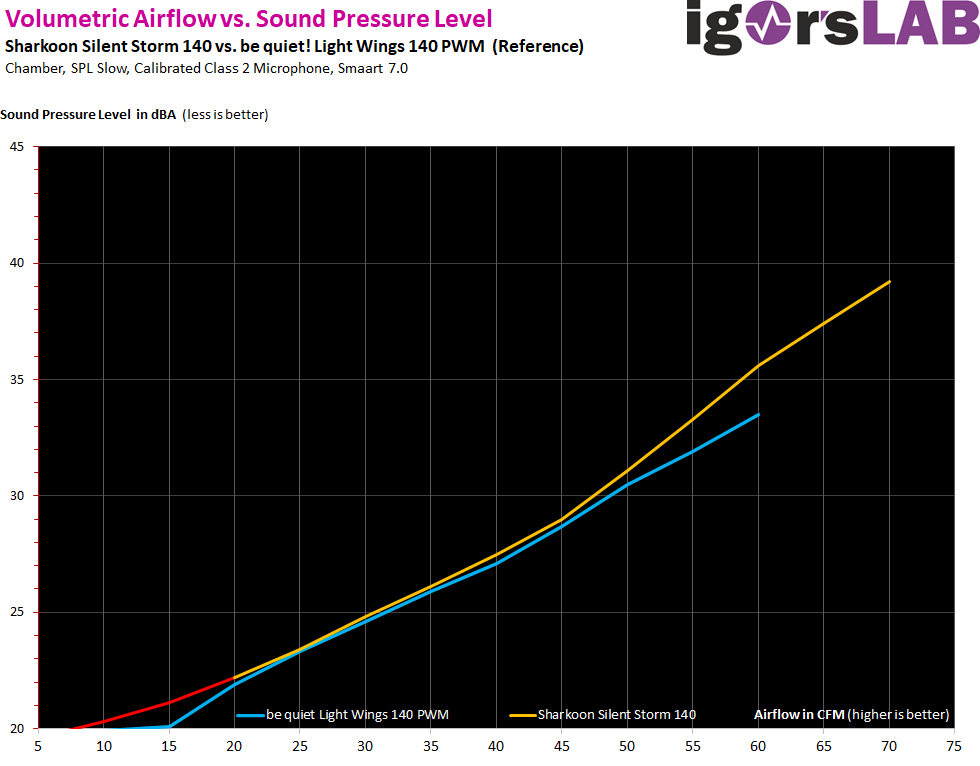Volume flow vs. sound pressure level
You get a very appealing performance here in the case and especially on the radiator along with a wide speed band, especially in the lower range as well. The Sharkoon Silent Storm 140 mm is barely louder than the reference in relation to the airflow up to about 900 rpm and 50 cfm, but extremely outclasses it on the radiator and still manages decent throughput at an acceptable sound level at the top end of the speed range. That is a real big number for plenty of 10 Euros, especially since the fan was almost from humming and audible vibrations. You can leave it like that, because it actually hardly gets much better for this price.
Those who install the Sharkoon Silent Storm 140 mm should, despite everything, pay attention to the structure-borne noise and vibrations, which can quickly find a resonator and then put the fan acoustically on the sidelines, even if the fan is decoupled quite well by the huge rubber corners. After all, things like this are precisely the reason why we work with a large-volume and very rigid chamber rather than a thin and long wind tunnel. This also applies to the end user, who may please pay attention to a good decoupling here.
Volume flow and speeds
Looking at the graph, the curve is similarly balanced to that of the reference fan. The almost linear ascent is very good and also the curve at the top does not simply flatten out. Of course, a big thumbs up for this as well. The fact that the upper limit was limited to 1400 rpm doesn’t detract from the whole thing, since most users will prefer 1000 rpm and less anyway. And you also beat the reference in total, especially on the radiators of all thicknesses and fin shapes, thanks to the static pressure.
So you can see that the fan delivers what we had promised after the test of the smaller model and what the price does not let you assume at first. The fact is that the Sharkoon Silent Storm 140 mm delivers more than decent overall and in comparison to the reference, especially in radiator mode. The performance, especially at lower speeds, is also completely convincing, even if the fan naturally decreases a bit then. Compared to other fans with nicely colored values in the spec sheet, the Sharkoon Silent Storm 140 mm still delivers decently
There is also a purchase tip for this and it is honestly deserved, since it is more than just a cheap home in terms of price. Of course, you can also use it as a case fan, heavily regulated down, but you save push-pull operation on radiators, which then turns out much quieter in total against two fans. I gave it a purchase tip for exactly this reason, although the really only slight humming in the free setup as a case fan (hardly ever occurs on radiators, by the way) almost put me off it anyway. We are, after all, thorough. But you have to appreciate the brute pressure that makes these measurement results possible in the first place. And the fan is not even loud for that.
Conclusion
Sharkoon Loop (copied from the 120 model): Those who cannot or do not want to do without RGB and also do not have a fat wallet will certainly be happy with the Sharkoon Silent Storm 140 mm. As a case fan, the part fits, but especially in use on radiators of all kinds. There, the Sharkoon Silent Storm 140 mm is a really smart, because also cheap choice that does not blow your ears off. In the introduction on the first page, I already indirectly wrote something about the bar in the form of such a low purchase price. The fan really skipped this one grandiosely, even if you wouldn’t have suspected it that way. Only the daisy chain we have again very painfully missed – so please improve!



































45 Antworten
Kommentar
Lade neue Kommentare
Veteran
Urgestein
Mitglied
Veteran
Urgestein
Veteran
Veteran
Mitglied
Urgestein
1
Veteran
Urgestein
Urgestein
Urgestein
Urgestein
Mitglied
Alle Kommentare lesen unter igor´sLAB Community →